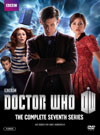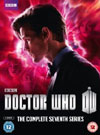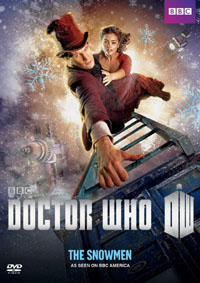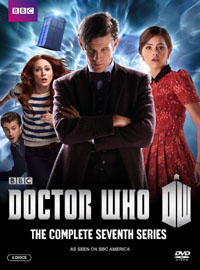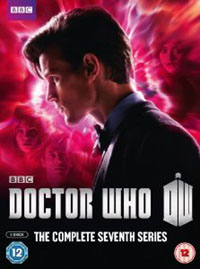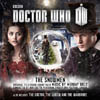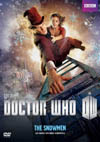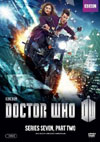DVD Extras for this story on the 15-episode box sets include:
But lots of Christmas Specials past have sported equally interesting companion themes. "The Snowmen" charges ahead much further by introducing the main villain(s) for the season here, in what is probably their most definitive story yet. You've "seen" this villain before, and yet you haven't. We get hints that this may in fact be the genesis of the Great Intelligence, and yet again, maybe it isn't. Casting is brilliant in harnessing the acting talent of Richard E. Grant on screen, who makes an excellently chilling adversarial mastermind, while Ian McKellen's superb vocal work gives today's enemies their aura of great power.
1892 for all the right reasonsThe setting works for a lot of different reasons. Because it is Earth, 1892, it makes logical sense that the Intelligence spawned here will try a comeback in Tibet in the 1920's or 1930's in "The Abominable Snowmen" (story no. 38), and that they might use the information they got from the Doctor here to invade the London Underground some forty odd years later in "The Web of Fear" (story no. 41), a story which amazingly just got returned to us fans recently. (Yes!) Thus writer Steven Moffat seems to be cleverly patching up a few motivational holes in those previous two tales, and adding some modern credibility to the villain's abilities. Nice.Also, if you are going to embrace the Christmas element for a Christmas show, probably nothing works better than Europe in the 1800's - where most dominant western Christmas traditions crystallized. That simpler time we all seem to yearn for around December flourishes in the 1800's. Though there are a few outdoor shots in this tale that unfortunately look like summer sprayed with white powder, the setting is well-realized for the most part, evoking a good Christmas feeling. And then there's my favourite reason for coming here. 1892 marks four years after we saw the Silurian Madame Vastra being recruited from here for "Demons Run" (story no. 223), and now she and Jenny Flint are back with ex-nurse Sontaran Commander Strax. I can't say it enough: I love this trio!! We get to dig deeper into the cultural idiosyncrasies of Doctor Who's long-standing alien races without repeating the Earth-invasion and backyard-alien-of-the-week plots that have been done to death on this show already, which is a plus all around. Also, these three characters unite like a group of comic-book superheroes, each with unique perspectives and abilities and temperaments. There's also a ton of humour in their interaction, and this script nicely plays that element up. I love it! To really get into this trio's backstory, you will need to dig into the bonus prequel scenes, which nicely fill us in on why Vastra is here at this time, and how Strax came to join her and Jenny. Apparently, only the 15-episode full season box sets have all three prequel scenes.
Built for the StarsThis story also introduces some stylistic tweaks to the show that will continue as it goes forward. First up is the new title sequence, which is fantastic! Outer space has never been done better justice in any Doctor Who title sequence before - this is not just empty vacuum with a moving starfield, this is bursting full of nebulas and all sorts of astronomical unknowns that beg for closer investigation and more study. Much of it reminds me of the slightly ambiguous slides seen in the travel montage of episode 5 of "The Dalek Masterplan". But nearer the end it can clearly be identified as outer space. I love the synchronization of the camera moves with the chord changes in the music. And we get the Doctor's face in a nebula - is it a result of some kind of copying mechanism like the unknown crystalline lifeforms of "Midnight", or memory snow, remembering a visit from him fondly? After all that, a time-vortex tunnel opens up, and we get what is perhaps a bit more of a traditional image for a title sequence. Excellent. Most previous titles focused on either time or space, but this one delivers both quite powerfully, and is possibly my absolute favourite from all 50 years put together.The end credits are a bit more of a problem - with white letting on a bright red background, its legibility is seriously undermined. Happily this is improved as the second-half of the season gets underway. The music has changed slightly as well, but I'm on the fence as to whether it really improved over the previous version. "The Snowmen" features a lot of extra sound effects on its title that don't appear during the rest of the season - I particularly miss the high-pitch rhythmic sweetener over the opening bars when it disappears since it seemed to highlight the astronomical qualities of what we were looking at. But it is good that most of the other sound effects were either toned down or removed - the sound of the TARDIS felt too distracting in the titles. I also don't think the doors should open up to reveal footage from the episode unless it's an actual scene in the TARDIS interior. Ah well. Long live space exploration on Doctor Who! This title sequence celebrates it gorgeously! Though designer Michael Pickwoad had joined the series for the previous season, it isn't until here in "The Snowmen" that he gets his chance to create his own TARDIS interior - and his is the first TARDIS interior for the New Millennium version of the show that I truly like. It actually looks like it could function the way it was meant to, while resembling the most definitive versions from the classic show in all the right places. Excellent! I love the hexagonal console, now sporting good-looking technology and interfaces all over it, plus the smart addition of controls around the outside of the area surrounding it. The walls around have gone back to the hexagonal pattern that seemed to elude the previous designer. The area around the main door has been beefed up to suggest that it just might sprout a second set of inner doors and function as an airlock if the correct control is operated. And there are plenty of other exits from the console room to lead to the rest of the interior. All to the good. The only thing missing so far is to get a nice big scanner screen covering most of one wall.
Poppin' Into the TARDISOne other element of this story we haven't mentioned yet is all the imagery pinched from Mary Poppins. It remains ambiguous whether or not this element helped more than it hindered. The crossover is limited to Clara putting on a Poppins-like dress, heading off to be a nanny for a pair of children, and using an umbrella and a magical staircase to ascend into the clouds. The umbrella really is just a knowing wink from Moffat towards the material that inspired him. Clara always seems to be all about entertaining (and thus shaping) young people in all her different manifestations.The concept of parking the TARDIS in the clouds is the most questionable move in this piece. The best reason for doing it is to symbolize the Doctor's detachment from the world, while the Poppins homage is slightly cute. But the downside is a little stronger here. Moffat isn't quite able to make the science of it sound or feel believable. More to the point, why would the Doctor in his deep state of apathy go to all the trouble to figure it out? Imitating Santa's drop down a chimney during a state of mischievous glee maybe, but this? Of course the biggest nail in the coffin is that if he hadn't been so ridiculous as to park the TARDIS on a cloud, Clara might not have lost her life in such a ridiculous fashion. As in the previous episode, Moffat is trying to engineer a companion's downfall, but I think it should have been done in a way that primarily makes the villain look powerful. The way he did it here brings the whole cloud-parking move of the Doctor's under increased scrutiny that it can't really withstand, which then makes his character look too foolish. Of course, anyone who remembers those dramatic moments when the TARDIS rescues River Song from a fatal fall in "The Time of Angels" (story no. 211) and "The Impossible Astronaut" (story no. 219) may well wonder why one isn't attempted here. At least the awful "The Angels Take Manhattan" (the previous story) contrived a reason for not attempting such a rescue when it was needed then, but here we get no attempt at an excuse whatsoever. In fact, it's made all the more strange by having the Doctor pick Clara up in the TARDIS anyway. Why does he only materialize after it's already too late? How difficult is it to arrive a bit earlier, swimming pool at the ready? Well, the saving grace here is that this occurrence is but one surprise moment of action that the characters arrive at by accident and carelessness in a story full of other worthy events and elements, instead of an idiotically deliberate decision which served as the previous story's only reason for existence. It's not a great move here, but it's the story's only major gaffe, and it still does manage to serve the ongoing mystery and tapestry of the season. Perhaps the best reason that this story gets away with it is that it manages to give us a glimpse of yet another living breathing modern-day Clara that the Doctor wants to find just before the credits roll. Nice move. I will also say that although it's nice to see the TARDIS get around quite a bit during the later portions of this story, it is quite bizarre how reluctant the crew is to show a good materialization. Are they trying to save on the budget to show us other things? If so, perhaps they shouldn't have overcomplicated the effect - a simple easy roll-back-and-mix is all I need to be satisfied. Or is it their modern reluctance to stay on any one shot long enough to show the effect in its entirety? Extending the attention span and mental focus of today's youth and today's adults is a worthy goal - all the more reason to put such things back in. Besides, the way things are shot in this story, I think an actual materialization in many places would be definite improvement.
I've always thought that Sherlock Holmes' deductive reasoning would be quite useless if he ever had to face the typical Doctor Who mystery plot, since Holmes likes to assume that only a very limited set of circumstances are possible, which he then whittles down to one through his obscure process of elimination. He'd be totally discombobulated using that to face the abundance of wild new possibilities that a Doctor Who mystery usually presents. Here, Moffat cleverly gives the Doctor a scene of bluffing his way into the villains' lair using Sherlock Holmes style reasoning, where its ineffectiveness can be nicely satirized. Then somewhere along the way, he morphs into the Doctor again, cutting through to the heart of matters. It's a very nice touch.
International Titles:Deutsch: "Die Schneemänner"Magyar: "A hóemberek"Français: "La Dame de glace"Русский: "Снеговики"Italiano: "I pupazzi di neve"The French decided to focus on a different element of the episode for their title: "The Lady of Ice"
This story has become available on DVD and Blu-ray.
This story is also available in North America in a single episode volume with fewer extra features. Click on the Amazon symbol for the location nearest you for pricing and availability:
U.K. customers will find "The Snowmen" included on their 9-episode volume for "Series 7, Part Two":
Comments on this article are welcome. You may contact the author from this page:
|
||||||||||||||||||||||||||||||||||||||||||||||||||||||||||||||
